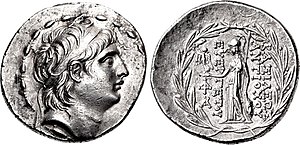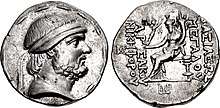Phraates II
Phraates II (also spelled Frahad I; Parthian: 𐭐𐭓𐭇𐭕 Frahāt) was king of the Parthian Empire from 132 BC to 127 BC. He was the son and successor of Mithridates I (r. 171–132 BC). Because he was still very young when he came to the throne, his mother Rinnu initially ruled on his behalf. His short reign was mainly marked by his war with the Greek Seleucid Empire, who under king Antiochus VII Sidetes (r. 138–129 BC) attempted to regain the lands lost to Phraates' father. Initially unsuccessful in the conflict, Phraates managed to gain the upper hand and defeated Antiochus VII's forces, with the Seleucid himself dying in battle or committing suicide. Phraates II afterwards rushed to the east to repel an invasion by nomadic tribes—the Saka and Yuezhi, where he met his end. He was succeeded by his uncle Artabanus I.
| Phraates II 𐭐𐭓𐭇𐭕 | |
|---|---|
| Great King, Arsaces, Philhellene | |
%2C_Seleucia_mint.jpg) Coin of Phraates II, minted at Seleucia in 129 BC | |
| King of the Parthian Empire | |
| Reign | 132–127 BC |
| Predecessor | Mithridates I |
| Successor | Artabanus I |
| Born | c. 147 BC |
| Died | 127 BC (aged 19 or 20) |
| Spouse | Laodice |
| Dynasty | Arsacid dynasty |
| Father | Mithridates I |
| Mother | Rinnu |
| Religion | Zoroastrianism |
Name
Phraátēs (Φραάτης) is the Greek form of the Parthian Frahāt (𐭐𐭓𐭇𐭕), itself from the Old Iranian *Frahāta- ("gained, earned").[1] The Modern Persian version is Farhād (فرهاد).[2]
Background
Phraates II was born in c. 147 BC; he was the son of Mithridates I, the fifth Parthian king, and a noblewoman named Rinnu, who was the daughter of a Median magnate.[3]
Reign

Phraates succeeded his father in 132 BC; due to still being a minor, his mother ruled with him for a few months.[4] Around this period, Phraates gave Darayan I kingship over the southern Iranian region of Persis.[5] In 130 BC the Parthian empire was attacked from the west. Antiochus VII Sidetes (r. 138–129 BC), king (basileus) of the Seleucid Empire, attacked in the west to reconquer territory lost earlier. After three battles he reclaimed Babylonia.[6][7] After this he offered a peace, by which he would regain Mesopotamia and large parts of Iran. The Parthian realm would be restricted to its core territories and would pay a heavy tribute. Phraates II could not accept these high demands, so he refused the offer. In the following winter (129 BC), Antiochus VII quartered himself and his army in Ecbatana, where he completely alienated the local people by forcing them to pay for the upkeep of his soldiers and because, it seems, the soldiers assaulted the locals.[6] Thus, when Phraates II attacked the Seleucid army in its winter quarters, the local population supported him. Antiochus VII was defeated and killed or committed suicide, ending Seleucid rule east of the Euphrates.[8]
Phraates II succeeded in capturing Seleucus and Laodice, two of his children who had accompanied their father on campaign. Phraates II later married Laodice and showed Seleucus (not to be confused with his cousin Seleucus V) great favour.[9] He allowed Antiochus VII a royal funeral and later returned the body to Syria in a silver coffin along with Seleucus.[10] Phraates II also released Demetrius II Nicator, who had been held by the Parthians as a hostage for several years, to become king of the Seleucid realm for a second time.
Syria, which was now all that was left of the Seleucid empire, lacked military power and Phraates II apparently planned to invade it. However, on the eastern front, various nomadic tribes already infiltrating and usurping the Saka and Tokhari destroyed the Greco-Bactrian Kingdom, penetrated to the borders of the realm in 129 BC, and threatened the Parthian realm.[11] The king had to rush to the eastern front, installing Himeros as governor of Babylon, who quickly became a tyrant. Phraates II marched east, his army including a large force of captured Seleucid soldiers from the army of the late Antiochus VII Sidetes. These soldiers ultimately refused to fight for the Parthian king, and he was defeated and killed in battle.
Coinage and Imperial ideology

Phraates refrained from using the title of "King of Kings" in his coinage, and instead used the title of "great king".[12] Like the rest of the Parthian kings, he used the title of Arsaces on his coinage, which was the name of the first Parthian ruler Arsaces I (r. 247 – 217 BC), which had become a royal honorific among the Parthian monarchs out of admiration for his achievements.[13][14] Furthermore, he also used the title of Philhellene ("friend of the Greeks"),[15] which had been introduced during the reign of his father Mithridates I (r. 171 – 132 BC) as a political act in order to establish friendly relations with their Greek subjects.[16] An unusual title attested during the reign of Phraates was the title of "King of the Lands" (attested in Babylonian cuneiform tablets as šar mātāti), which was rarely used by the Seleucid monarchs.[17] Like his father, Phraates is wearing a Hellenistic diadem, whilst his beard represents the traditional Iranian/Near Eastern custom.[18]
References
- Schmitt 2005.
- Kia 2016, p. 160.
- Assar 2006, p. 58.
- Assar 2009, p. 134.
- Shayegan 2011, p. 178.
- Justin, xli. 38.
- Shayegan 2011, pp. 128-129.
- Bing & Sievers 1986, pp. 125–135.
- Ogden, Daniel (1999). Polygamy Prostitutes and Death. The Hellenistic Dynasties. London: Gerald Duckworth & Co. Ltd. p. 150. ISBN 07156-29301.
- Justin, xli. 39.
- Grousset 1970, p. 31.
- Shayegan 2011, pp. 41-42.
- Daryaee 2012, p. 169.
- Kia 2016, p. 23.
- Curtis 2007, p. 11.
- Daryaee 2012, p. 170.
- Shayegan 2011, p. 43.
- Curtis 2007, p. 9.
Bibliography
Ancient works
- Justin, Epitome of the Philippic History of Pompeius Trogus.
Modern works
- Assar, Gholamreza F. (2006). A Revised Parthian Chronology of the Period 91-55 BC. Parthica. Incontri di Culture Nel Mondo Antico. 8: Papers Presented to David Sellwood. Istituti Editoriali e Poligrafici Internazionali. ISBN 978-8-881-47453-0. ISSN 1128-6342.CS1 maint: ref=harv (link)
- Assar, Gholamreza F. (2009). "Artabanus of Trogus Pompeius' 41st Prologue". Electrum. Kraków. 15.CS1 maint: ref=harv (link)
- Bing, D.; Sievers, J. (1986). "Antiochus". Encyclopaedia Iranica, Vol. II, Fasc. 2. pp. 125–135.CS1 maint: ref=harv (link)
- Brown, Stuart C. (1997). "Ecbatana". Encyclopaedia Iranica, Vol. VIII, Fasc. 1. pp. 80–84.CS1 maint: ref=harv (link)
- Bickerman, Elias J. (1983). "The Seleucid Period". In Yarshater, Ehsan (ed.). The Cambridge History of Iran, Volume 3(1): The Seleucid, Parthian and Sasanian Periods. Cambridge: Cambridge University Press. pp. 3–20. ISBN 0-521-20092-X.
- Bivar, A.D.H. (1983). "The Political History of Iran under the Arsacids". In Yarshater, Ehsan (ed.). The Cambridge History of Iran, Volume 3(1): The Seleucid, Parthian and Sasanian Periods. Cambridge: Cambridge University Press. pp. 21–99. ISBN 0-521-20092-X.
- Brosius, Maria (2006), The Persians: An Introduction, London & New York: Routledge, ISBN 0-415-32089-5
- Curtis, Vesta Sarkhosh; Stewart, Sarah, eds. (2007), The Age of the Parthians, Ideas of Iran, vol. 2, London: I. B. TaurisCS1 maint: ref=harv (link)
- Curtis, Vesta Sarkhosh (2007), "The Iranian Revival in the Parthian Period", in Curtis, Vesta Sarkhosh and Sarah Stewart (ed.), The Age of the Parthians: The Ideas of Iran, 2, London & New York: I.B. Tauris & Co Ltd., in association with the London Middle East Institute at SOAS and the British Museum, pp. 7–25, ISBN 978-1-84511-406-0
- Colledge, Malcolm A. R. (1977). Parthian art. Elek. pp. 1–200.CS1 maint: ref=harv (link)
- Dąbrowa, Edward (2010). "The Arsacids and their State". XI: 21–52. Cite journal requires
|journal=(help)CS1 maint: ref=harv (link) - Dąbrowa, Edward (2013). "The Parthian Aristocracy: its Social Position and Political Activity". Parthica. 15: 53–62.CS1 maint: ref=harv (link)
- Dąbrowa, Edward (2018). "Arsacid Dynastic Marriages". Electrum. 25: 73–83. doi:10.4467/20800909EL.18.005.8925.CS1 maint: ref=harv (link)
- Daryaee, Touraj (2012). The Oxford Handbook of Iranian History. Oxford University Press. pp. 1–432. ISBN 978-0-19-987575-7.CS1 maint: ref=harv (link)
- Frye, Richard Nelson (1984). The History of Ancient Iran. C.H.Beck. pp. 1–411. ISBN 9783406093975.
false.
CS1 maint: ref=harv (link) - Garthwaite, Gene Ralph (2005), The Persians, Oxford & Carlton: Blackwell Publishing, Ltd., ISBN 1-55786-860-3CS1 maint: ref=harv (link)
- Grousset, René (1970). The Empire of the Steppes: A History of Central Asia. Rutgers University Press. pp. 1-687. ISBN 9780813513041.CS1 maint: ref=harv (link)
- Invernizzi, Antonio. "Nisa". Encyclopaedia Iranica.CS1 maint: ref=harv (link)
- Kennedy, David (1996), "Parthia and Rome: eastern perspectives", in Kennedy, David L.; Braund, David (eds.), The Roman Army in the East, Ann Arbor: Cushing Malloy Inc., Journal of Roman Archaeology: Supplementary Series Number Eighteen, pp. 67–90, ISBN 1-887829-18-0
- Hansman, John F. (1998). "Elymais". Encyclopaedia Iranica, Vol. VIII, Fasc. 4. pp. 373–376.CS1 maint: ref=harv (link)
- Kia, Mehrdad (2016). The Persian Empire: A Historical Encyclopedia [2 volumes]: A Historical Encyclopedia. ABC-CLIO. ISBN 978-1610693912.CS1 maint: ref=harv (link)
- Nabel, Jake (2017). "The Seleucids Imprisoned: Arsacid-Roman Hostage Submission and Its Hellenistic Precedents": 25–50. Cite journal requires
|journal=(help)CS1 maint: ref=harv (link) - Olbrycht, Marek Jan (2010). "Mithradates I of Parthia and His Conquests up to 141 B.C.": 229–245. Cite journal requires
|journal=(help)CS1 maint: ref=harv (link) - Pourshariati, Parvaneh (2008). Decline and Fall of the Sasanian Empire: The Sasanian-Parthian Confederacy and the Arab Conquest of Iran. London and New York: I.B. Tauris. ISBN 978-1-84511-645-3.CS1 maint: ref=harv (link)
- Schippmann, K. (1986). "Arsacids ii. The Arsacid dynasty". Encyclopaedia Iranica, Vol. II, Fasc. 5. pp. 525–536.CS1 maint: ref=harv (link)
- Schmitt, Rüdiger (2005). "Personal Names, Iranian iv. Parthian Period". Encyclopaedia Iranica.CS1 maint: ref=harv (link)
- Shayegan, Rahim M. (2007), "On Demetrius II Nicator's Arsacid Captivity and Second Rule", Bulletin of the Asia Institute, 17: 83–103
- Shayegan, M. Rahim (2011). Arsacids and Sasanians: Political Ideology in Post-Hellenistic and Late Antique Persia. Cambridge University Press. pp. 1–539. ISBN 9780521766418.CS1 maint: ref=harv (link)
- Sellwood, David (1983). "Minor States in Southern Iran". In Yarshater, Ehsan (ed.). The Cambridge History of Iran, Volume 3(1): The Seleucid, Parthian and Sasanian Periods. Cambridge: Cambridge University Press. pp. 299–322. ISBN 0-521-20092-X.
- Wiesehöfer, Josef (2000). "Frataraka". Encyclopaedia Iranica, Vol. X, Fasc. 2. p. 195.CS1 maint: ref=harv (link)
Phraates II Arsacid dynasty Died: 127 BC | ||
| Preceded by Mithridates I |
King of the Parthian Empire 132–127 BC |
Succeeded by Artabanus I |